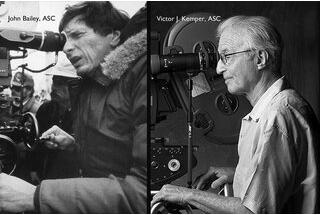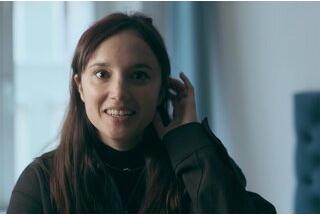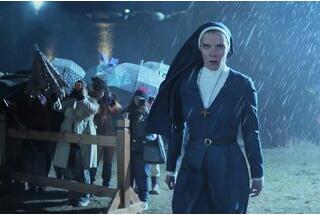Interview with Cinematographer Linus Sandgren, FSF, about his work on Damien Chazelle’s “La La Land”
Fall in love with HollywoodCurrently working on the shooting of The Nutcracker in Pinewood, Disney’s latest production (directed by his countryman, Lasse Halstrom), Linus Sandgren, FSF, took advantage of an “off” moment to talk with us about the creation of La La Land, by Damien Chazelle. Reprising the theme of success from his first film, Whiplash, this romantic and musical comedy is above all a tribute to Hollywood, to the year 1955, and to silver-process film, with which it was filmed. A dazzling film that is reminiscent of One From the Heart, Francis Ford Coppola’s pharaonic and damned attempt at a musical comedy in 1982 with cinematography by Vittorio Storaro, AIC, ASC (FR)
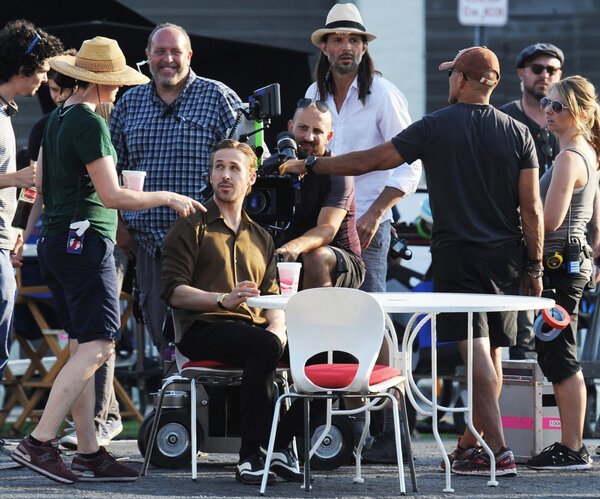
The camera as a third character
“Damien Chazelle introduced the film to me as a film about the dreams that people have –and especially about achieving them,” explains Linus Sandgren. Beginning from several the film’s musical compositions, delivered by Justin Hurwitz in advance of the beginning of preparation for the film, and choosing the city of Los Angeles as their set, the director and the director of photography spent a long time preparing for this cinematographic feat.
The main difficulty for us was being able to create a movie that goes from intimate moments to truly enchanted moments without any visible transition, inside of a city that is the city of dreams par excellence. This was Damien’s way of showing that magic can happen anywhere, even in rather sordid places, like the night-time scene in front of the cheap theatre where Mia puts on her show. Everything was a pretext for magic for us.”
The director wanted to honour tradition – both in terms of jazz and of cinematography – and also wanted to honour a certain classicism in the film itself, taking A Star Is Born (George Cukor, 1954) and Rebel Without a Cause (Nicholas Ray, 1955) as references. “On La La Land, I felt it was important to treat the camera as a third character,” Sandgren added.
“Damien explained to me that the camera ought to move around in the same way the characters dance, and interact with them in response to their emotions. A good example is the series of panoramic shots that are repeated in the opening shot, which was my way of being both camera and actor in a way. I was very influenced by Vittorio Storaro’s camera movements on rails or on cranes for Bertolucci’s films for the camera movements on this film.
Although one is taken aback by the temporal strength of the performance, beginning with the stunning opening scene (a gigantic choreography that takes place in the middle of a highway traffic jam that stretches as far as the eye can see), nonetheless the film does not rely on virtuoso master shots: “we didn’t set any rules or procedures for ourselves,” Sandgren explains. “Of course, most of the time, we tried to draw out the shots but that wasn’t always the case.”
There are a few scenes that were broken down (like the argument in the kitchen in front of dinner). The only decision was to do everything directly, in the old-fashioned way with 35mm film. We didn’t use any green screen or digital effects. I am thinking specifically of the scene in the wooden pontoon at the edge of the dock with the sun setting behind the actors, which was shot in five takes within the space of 45 minutes.”
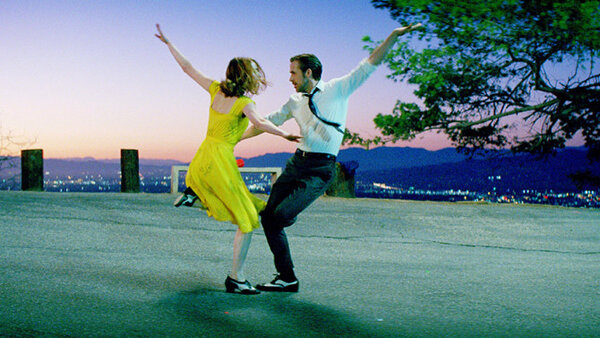
Shot on location
The entire film was shot on location, and so preparation was one of the keys of this film’s success. “Be it for the dancing or the acting, Ryan Gosling and Emma Stone took three months before shooting began to rehearse and perfect the singing and dancing scenes with us. Then, the assistant director put together a shooting script that let us warm up and begin the main feats with plenty of rehearsal on location. For example, we needed two full days of rehearsal on location for the opening scene before we could begin shooting. First, we used an iPhone instead of a camera, and then went on to use the telescopic crane, the Panaflex, and the problems related to the shadows they cast on the ground because of the sun that I am sure you can imagine!”
Another key scene was the first romantic moment between Mia and Sebastian, when they leave the party on the mountain above the city and go looking for their respective cars. “On this set, located in the mountains above Los Angeles, I had to overcome several challenges. First of all, the lack of space for the equipment. The road was narrow and the shot had to cover a lot of breadth. After having set up the base of the 50-foot Technocrane, we didn’t have a lot of options for the rest! Furthermore, that part of the road was particularly dark with almost no public lighting.
The production designer, David Wasco, helped me install slightly retro fake lampposts that look almost like gas lampposts from the turn of the century. We set them up with blue-green lights, mercury-vapour style. In order to avoid the problem of shadows caused by the movement of the crane, I was able to hang a very soft blue-green top light from a sling hidden inside the dead angle, and then a second sling hung further off allowed us to add a little counter-light. We had to use an entire day for rehearsal before we began shooting.
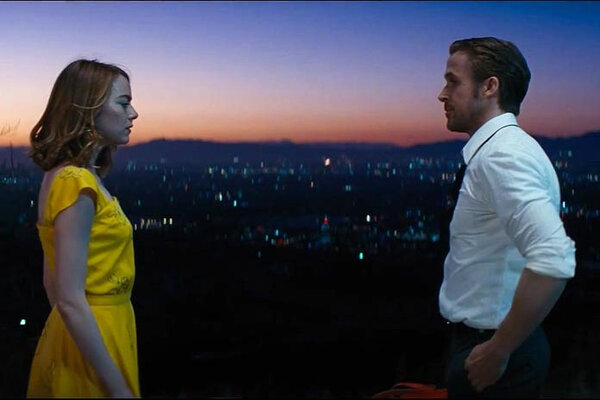
“Twenty-seven different marks were placed for the grips and the cameramen, while Emma and Ryan had to adapt to the difficulty of performing the choreography they’d learned in a dance studio on the asphalt of the road and its soft margin! At 7 p.m., we began the first take, and three others had taken place by 7:50 p.m. Only two were usable. Damien decided he wanted this scene to be filmed without cuts, so the only solution was to do it as a master shot. We came back the next day at 5 p.m. so that we’d be ready by 7 p.m. and that time we squeezed in six takes, the penultimate of which, I believe, was chosen for the final cut. You’ll notice in the take that the pink sky becomes more orange and the counterpoint of the cold light that is showering down on them. To balance out the scene, the costume designer created a special yellow robe for Emma that plays the counterpoint, while Ryan is dressed in a white shirt and a dark blue pair of trousers. In the film, this fairy-like scene is associated with daybreak because the prior scene in the street was filmed in the middle of the night at another location.”
The choreography of lighting
Another scenographic innovation that enhances the film’s magical side was the use of lights on dimmers to suddenly make the actors stand out from the set. “Both Mia and Sebastien wanted to succeed in their own ways and to be in the spotlight (as an actress and a musician, respectively). That’s the idea I translated by the searchlight used in several scenes, like when they meet one-on-one in the piano bar. In that shot on location, the sparks pulled off a real achievement because everything had to be packed up in the space of one night. All of the prop lights, sconces, and restaurant lights had to be separately rewired on three different circuits that could be controlled in real-time by three electricians who responded to the actors’ and cameras’ timing.
That was the very analogue, very simple side of the setups that prevailed throughout the entire film. Exactly like in the scene where they both go to the cinema to see Rebel Without a Cause and where the lighting that lights them is just a few flexible reflectors held by sparks on set that just sheds simple light on them.”
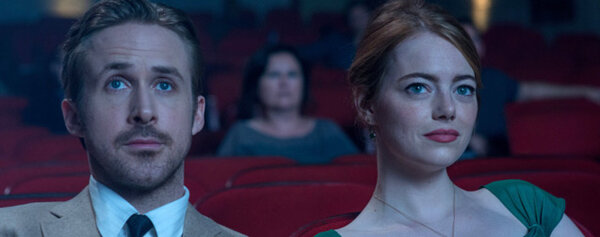
Playing on a Steinway
As for the choice of camera angles and shooting techniques, Damien Chazelle made no concession to current digital standards, either, as he decided to shoot this film in 35mm. Linus Sandgren provides us the following details: “Of course, you can always film in digital and try to get it to look like 35mm by adding graininess and using LUTs… but honestly, it’s so much simpler to just get an almost-final result when shooting, without becoming entirely dependent upon the postproduction process and remaining certain that you can control everything yourself. Personally, I also shoot in digital sometimes, but every time I find myself in the colour timing room, I miss 35mm and its capacity to render skin tone and the depth of its colours.”
On La La Land, the director of photography chose a very classic 35mm anamorphic Panavision configuration. “Shooting with a Panavision Scope is like playing piano on a Steinway. My only regret was that the Fuji film that I used to use (e.g. on American Hustle) isn’t being produced anymore. I had to use Kodak 5219 that I underdeveloped by one aperture (to reduce the graininess a bit) and setting it at 200 ISO.”
As for the lenses, the cinematographer chose a combination of C and E series with a very particular 40mm lens at the centre of the scenography: “Because we knew we’d have to do those complicated master shots with a lot of movements in the axis and considerable variations in the scale of shots, we needed a medium wide-angle with minimal ad-hoc focusing capacities. Dan Sasaki of Panavision’s lens department specially had a C 40 mm modified for me so that it could perform a 50 cm minimal focus distance (instead of 75 cm). We used this lens on most of the shots.”
This passion for the Scope was even translated into a short series of Super 8 family films (at the end of the story) by the cinematographers: “For these images, we insisted on filming in anamorphic but chose the 16mm with an Aaton A-Minima equipped with a PV mount and the same lenses. It became a sort of CinemaScope handheld camcorder. It was a wonderful fealing that I am thinking of using as the main camera on First Man, the future film on Neil Armstrong that Damien and I are supposed to film together,” admits Linus Sandgren.
In terms of lighting, Linus Sandgren admits that he was very classic in his choice of lighting for La La Land: “Tungsten spots were my principal light sources most of the time, especially for the actors. The colour quality of an incandescent light source with its continuous spectrum guarantee me results. This isn’t always the case with LEDs, fluorecents, or HMIs. That doesn’t mean I don’t use them for night-time shots, background lighting, or for the “fill light”, but I rarely ever use them as the main light source. On the film I’m shooting now in 35 and 70mm film (Nutcracker), we have around 250 Arri Skypanels spread over the Pinewood studio’s grill. It’s an extremely convenient tool for this project, because it can be quickly adapted to every ambience, but I don’t use them to light faces.”
Filming to last
“I remember how quickly people in the industry began to say “Film is dead…digital has won” in 1999 when digital films began to be released, reminisces Linus Sandgren. “Today, they realize how wrong they were, especially when you rewatch those films that were shot with the first Sony 900 cameras! They’ve all prematurely aged and can’t compete with the 1950s films that have been restored from the original negatives. I hope, as do many cinematographers, that the cinema industry is going to come to its senses and allow us to choose what tools we use, instead of making us fall in step with this uniformity of the postproduction chain.
(Interview conducted by François Reumont on behalf of the AFC, and translated from French by Alexander Baron-Raiffe)
Watch the Trailer
 En
En
 Fr
Fr
